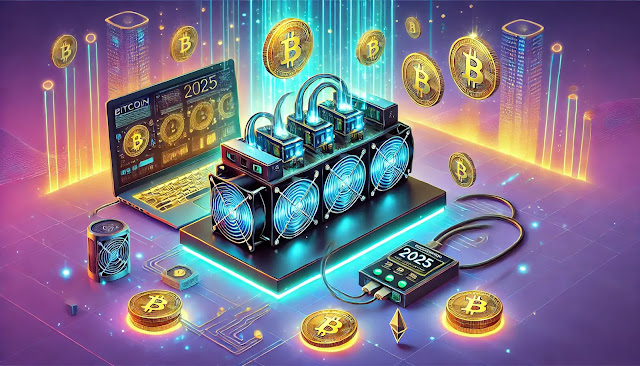How to Mine Bitcoin: Earn Passive Income From Crypto
Bitcoin mining is an exciting way to earn cryptocurrency while supporting the decentralized Bitcoin network. But how do you get started? This guide explains everything you need to know about how to mine Bitcoin in 2025, from tools to profitability. Let’s break it down.
What Is Bitcoin Mining?
Bitcoin mining is the process of verifying transactions on
the Bitcoin blockchain using powerful computers. Miners solve complex
mathematical puzzles to add new blocks to the chain, earning Bitcoin rewards in
return. It’s the backbone of Bitcoin’s security and decentralization. In 2025,
mining remains a blend of opportunity and challenge due to rising difficulty
and costs.
Read More: Top 10 AI & Big Data Crypto Tokens to Invest In 2025
Tools You Need to Mine Bitcoin
Before you start mining Bitcoin, gather these essentials:
- Hardware:
Application-Specific Integrated Circuits (ASICs) like the Bitmain Antminer
S19 are the gold standard. GPUs are less efficient but still usable for
beginners.
- Software:
Download mining software such as CGMiner or EasyMiner to connect your
hardware to the blockchain.
- Stable
Internet: A reliable connection ensures uninterrupted mining.
- Electricity:
Mining consumes significant power—check your local rates.
- Bitcoin
Wallet: A secure wallet (e.g., Ledger or a software wallet) stores
your rewards.
Investing in quality tools is key to success.
Step-by-Step Guide to Mining Bitcoin
Here’s how to mine Bitcoin in simple steps:
- Choose
Hardware: Buy an ASIC miner based on your budget and power
availability.
- Set
Up a Wallet: Create a Bitcoin wallet to receive your earnings.
- Join
a Mining Pool: Pools like Slush Pool or F2Pool combine computing power
for better reward chances.
- Install
Mining Software: Configure software with your pool’s details.
- Start
Mining: Power up your hardware, connect to the pool, and let it run.
Consistency and monitoring are crucial for steady results.
Costs and Profitability of Bitcoin Mining
Mining isn’t free. Electricity costs (e.g., $0.10-$0.30 per
kWh) can eat into profits, especially with power-hungry ASICs. Hardware prices
range from $1,000 to $10,000 depending on the model. In 2025, post-halving
rewards are 3.125 BTC per block, but competition is fierce. Use a mining
calculator (like WhatToMine) to estimate your ROI based on Bitcoin’s price and
your setup.
Advantages and Disadvantages of Bitcoin Mining
Pros:
- Earn
passive income in Bitcoin.
- Contribute
to a decentralized network.
Cons:
- High
energy consumption.
- Expensive
hardware and maintenance.
Weigh these factors before diving in.
Is Bitcoin Mining Still Worth It in 2025?
Profitability depends on electricity costs, Bitcoin’s market
price (hovering around $50,000-$100,000 historically), and mining difficulty.
Small-scale miners may struggle, but joining a pool or using renewable energy
can improve odds. Cloud mining is an alternative, though scams are
common—research thoroughly.
Tips for Successful Bitcoin Mining
- Optimize
Energy: Use solar power or low-cost electricity regions.
- Choose
the Right Pool: Look for low fees and high reliability.
- Cool
Your Hardware: Prevent overheating with fans or liquid cooling.
- Stay
Updated: Monitor Bitcoin trends and software updates.
Efficiency is your edge in mining.
Legal and Environmental Aspects
Mining laws vary globally. Some countries, like China, have
bans, while others, like the U.S., are more open. In India, check local
regulations as crypto policies evolve. Environmentally, mining’s carbon
footprint is debated—consider green energy to reduce impact.
Common Mistakes to Avoid
- Wrong
Hardware: Don’t waste money on outdated GPUs for Bitcoin.
- Ignoring
Costs: Underestimating electricity can lead to losses.
- Falling
for Scams: Avoid fake cloud mining sites promising unrealistic
returns.
Stay informed to protect your investment.
The Future of Bitcoin Mining
By 2025, expect more efficient ASICs and a shift toward
sustainable mining. As rewards halve, miners may rely more on transaction fees.
Small miners might need creative strategies to stay competitive.
Conclusion
Now you know how to mine Bitcoin! It’s a mix of technical
setup, cost management, and patience. Start small, optimize your setup, and
join the Bitcoin revolution. Have questions? Drop them below!
Frequently Asked Questions (FAQ)
- Can
I mine Bitcoin on my laptop?
No, laptops lack the power for efficient Bitcoin mining. ASICs are required for meaningful results. - How
much does it cost to start mining Bitcoin?
Basic setups start at $1,000-$2,000 for hardware, plus electricity costs varying by location. - What
is a mining pool?
A mining pool is a group of miners combining computing power to increase reward chances, splitting profits. - How
long does it take to mine 1 Bitcoin?
It depends on your hardware’s hash rate and pool luck—solo miners might take years; pools offer smaller, frequent payouts. - Is
Bitcoin mining legal?
Yes, in most countries, but check local laws—some regions like China have banned it. - Can
I mine Bitcoin for free?
No, mining requires hardware, electricity, and internet—there’s no "free" way to do it profitably. - What’s
the best Bitcoin mining hardware in 2025?
ASICs like Bitmain Antminer S19 or WhatsMiner M50 are top choices for efficiency and power. - How
much electricity does Bitcoin mining use?
A typical ASIC consumes 3,000-4,000 watts, running 24/7—calculate costs based on your local rates. - Is
cloud mining a good option?
It can be, but beware of scams. Research reputable providers like Genesis Mining carefully. - How
do I know if mining is profitable for me?
Use a mining calculator with your electricity cost, hardware specs, and current Bitcoin price to check.












0 Comments